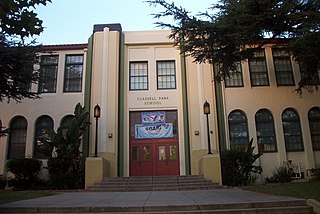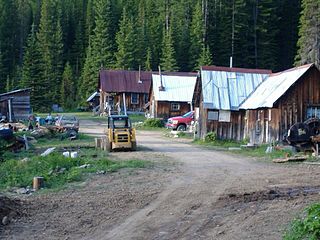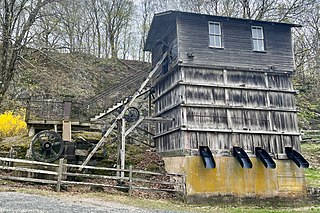
This is intended to be a complete list of properties and districts listed on the National Register of Historic Places in Orleans County, New York. The locations of National Register properties and districts may be seen in a map by clicking on "Map of all coordinates". Two listings, the New York State Barge Canal and the Cobblestone Historic District, are further designated a National Historic Landmark.

Glassell Park Elementary School is an elementary school listed on the National Register of Historic Places. It is located at 2211 W. Avenue 30, in the Glassell Park neighborhood of Los Angeles, California. It is a PK-6 active school. The principal is Ms. Claudia Pelayo. It is a part of the Los Angeles Unified School District (LAUSD).

The Las Vegas High School Historic District in Las Vegas, Nevada is a historic district which includes 11 buildings on the 15 acres (6.1 ha) campus of the school district. It was listed on the National Register of Historic Places in 2022.

There are 75 properties listed on the National Register of Historic Places in Albany, New York, United States. Six are additionally designated as National Historic Landmarks (NHLs), the most of any city in the state after New York City. Another 14 are historic districts, for which 20 of the listings are also contributing properties. Two properties, both buildings, that had been listed in the past but have since been demolished have been delisted; one building that is also no longer extant remains listed.

The Graham Building is a 1926 Prairie style building on Stolp Island in Aurora, Illinois. It was individually listed on the National Register of Historic Places in 1982. Also, it is a contributing property in a historic district.

The 1916 Buffalo High School, also known as Buffalo-Tower City Senior High School, is a property in Buffalo, North Dakota that was listed on the National Register of Historic Places (NRHP). It is located near the center of Buffalo, near the Old Stone Church which is also NRHP-listed.
The Grand Forks Near Southside Historic District is a 182-acre (74 ha) historic district in Grand Forks, North Dakota that was listed on the National Register of Historic Places (NRHP) in 2004.

The Shelby County Courthouse in Harlan, Iowa, United States, was built in 1892. It was individually listed on the National Register of Historic Places in 1978 as a part of the County Courthouses in Iowa Thematic Resource. In 1994 it was included as a contributing property in the Harlan Courthouse Square Commercial District. The courthouse is the third building the county has used for court functions and county administration.

The Cathedral of the Immaculate Conception is a Catholic cathedral in Memphis, Tennessee, United States. It is the seat of the Diocese of Memphis. The parish buildings are contributing properties in the Central Gardens Historic District. It was listed on the National Register of Historic Places in 1982.

The Lander County High School, at 130 Sixth St. in Austin, Nevada, is a two-story concrete and brick school building built in 1926 with a connected, matching gymnasium that was built in 1928. It was designed by Reno, Nevada architects George A. Ferris and Son. It was built originally as a K-12 combined school, built from proceeds of a $55,000 bond. It has since also been known as Austin High School and, in 1999, as Austin Elementary School. It was listed on the National Register of Historic Places in 2000; the listing included both buildings as contributing buildings.

The Brick Schoolhouse is a historic one-room schoolhouse at 432 New Hampshire Route 123 in Sharon, New Hampshire. Built in 1832, it is the only of the town's three such buildings to survive, and was the only one made of brick. It is also the only school building now standing in the town, since its students have been schooled in neighboring Peterborough since 1920. The building was listed on the National Register of Historic Places in 2002, and the New Hampshire State Register of Historic Places in 2001.

The Willow–Bluff–3rd Street Historic District is a nationally recognized historic district located in Council Bluffs, Iowa, United States. It was listed on the National Register of Historic Places in 2005. At the time of its nomination the district consisted of 260 resources, including 162 contributing buildings, 56 contributing structures, 36 non-contributing buildings, and six non-contributing structures. The district is primarily a residential area that is adjacent to the central business district to the west. Part of the district is in Jackson's Addition, which is the first addition to the original town of Council Bluffs. It also sits along the base of the loess bluffs to the east.

The Prof. J.L. Budd, Sarah M., and Etta Budd House, also known as the Youth Recovery House, is a historic building located in Ames, Iowa, United States. It was built as a single family residence in 1885. The two-story brick structure was built using Italianate elements. After World War II it was converted into an apartment building, and later into institutional housing. The attached 1½-story Colonial Revival cottage was moved onto the property in 1963, and used for office space. The house is named for Joseph Lancaster Budd, a botanist at what is now Iowa State University, who helped establish the school's national reputation in horticulture. Sarah was his wife, and Etta was their daughter. She was an artist who was influential in bringing George Washington Carver to Iowa State College for his undergraduate education. Carver resided here briefly in 1891. The house was individually listed on the National Register of Historic Places in 2001, and it was included as a contributing property in the Old Town Historic District in 2004.

The Monroe Elementary School Historic District is a nationally recognized historic district located in Cedar Rapids, Iowa, United States. It was listed on the National Register of Historic Places in 2015. At the time of its nomination it consisted of 10 resources, which included one contributing building, one contributing site, three contributing objects, two non-contributing buildings, and three non-contributing objects. The school building was completed in 1961 in a neighborhood of small ranch-style houses from the same era. Designed by the Cedar Rapids architectural firm of Brown & Healey, it was one of seven schools built as a result of a bond referendum in 1959. It was necessitated by a roughly 70% increase in enrollment between 1950 and 1960. The single story, brick building features long and wide corridors, low ceiling heights, extensive use of glazing, exposed trusses, and deep overhangs. The building retains historical integrity, while the other school buildings built at this time in Cedar Rapids do not. Two basketball hoops and a fire engine-shaped piece of playground equipment are the contributing objects. The non-contributing buildings are two temporary classrooms, three pieces of playground equipment are the non-contributing objects. It ceased being a school building in 2011.

The Gildersleeve Mine, in Lolo National Forest near Superior in Mineral County, Montana, was a gold and barite mine listed on the National Register of Historic Places in 2002.

The Asbury Historic District is a 288-acre (117 ha) historic district encompassing the community of Asbury in Franklin Township of Warren County, New Jersey. It is bounded by County Route 632, County Route 643, Maple Avenue, Kitchen Road, and School Street and extends along the Musconetcong River into Bethlehem Township of Hunterdon County. It was listed on the National Register of Historic Places on March 19, 1993 for its significance in architecture, industry, religion, community development, politics/government, and commerce. The district includes 141 contributing buildings, a contributing structure, two contributing sites, and four contributing objects.

The M. C. Mulligan & Sons Quarry is a 8.8-acre (3.6 ha) historic district encompassing a former limestone quarry located at 56 Main Street in the town of Clinton in Hunterdon County, New Jersey. It was added to the National Register of Historic Places on August 30, 1994, for its significance in agriculture, commerce, and industry. The listing includes six contributing buildings, two contributing structures, a contributing object, and a contributing site. In 1995, it was also listed as part of the Clinton Historic District. The quarry is now in the Red Mill Museum Village, an open-air museum.

The Lincoln Park Historic District in Pomona, California is a 45-block, 230-acre residential neighborhood. The district consists of 821 structures—primarily single family homes built between the 1890s through the 1940s—featuring a wide variety of architectural styles from late Victorian and National Folk homes, Craftsman and Craftsman-influenced homes, as well as late 19th and 20th Century Revival architectural styles including Colonial, Mission/Spanish, Tudor and Classical Revival.
The University Neighborhood Historic District is a 180 acres (73 ha) historic district near the University of Utah campus in northeastern Salt Lake City, Utah, United States, that was listed on the National Register of Historic Places in 1995.
The W.L. and Winnie (Woodfield) Belfrage Farmstead Historic District is a nationally recognized historic district located south of Sergeant Bluff, Iowa, United States. It was listed on the National Register of Historic Places in 2017. At the time of its nomination it contained six resources, which included four contributing buildings and two non-contributing buildings. The four contributing buildings are the dairy barn (1910), farmhouse (1920), brooder house, and the chicken coop. The two no-contributing buildings are the cattle shed (1960) and the garage/utility building (2006).




















